Japan opts for massive, costly sea wall to fend off tsunamis
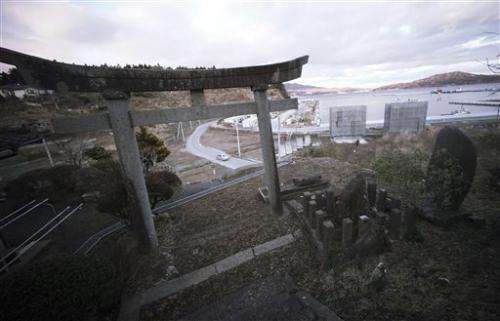
Four years after a towering tsunami ravaged much of Japan's northeastern coast, efforts to fend off future disasters are focusing on a nearly 400-kilometer (250-mile) chain of cement sea walls, at places nearly five stories high.
Opponents of the 820 billion yen ($6.8 billion) plan argue that the massive concrete barriers will damage marine ecology and scenery, hinder vital fisheries and actually do little to protect residents who are mostly supposed to relocate to higher ground. Those in favor say the sea walls are a necessary evil, and one that will provide some jobs, at least for a time.
In the northern fishing port of Osabe, Kazutoshi Musashi chafes at the 12.5-meter (41-foot)-high concrete barrier blocking his view of the sea.
"The reality is that it looks like the wall of a jail," said Musashi, 46, who lived on the seaside before the tsunami struck Osabe and has moved inland since.
Pouring concrete for public works is a staple strategy for the ruling Liberal Democratic Party and its backers in big business and construction, and local officials tend to go along with such plans.
The paradox of such projects, experts say, is that while they may reduce some damage, they can foster complacency. That can be a grave risk along coastlines vulnerable to tsunamis, storm surges and other natural disasters. At least some of the 18,500 people who died or went missing in the 2011 disasters failed to heed warnings to escape in time.
Tsuneaki Iguchi was mayor of Iwanuma, a town just south of the region's biggest city, Sendai, when the tsunami triggered by a magnitude-9 earthquake just off the coast inundated half of its area.
A 7.2-meter (24-foot) -high sea wall built years earlier to help stave off erosion of Iwanuma's beaches slowed the wall of water, as did stands of tall, thin pine trees planted along the coast. But the tsunami still swept up to 5 kilometers (3 miles) inland. Passengers and staff watched from the upper floors and roof of the airport as the waves carried off cars, buildings and aircraft, smashing most homes in densely populated suburbs not far from the beach.
The city repaired the broken sea walls but doesn't plan to make them any taller. Instead, Iguchi was one of the first local officials to back a plan championed by former Prime Minister Morihiro Hosokawa to plant mixed forests along the coasts on tall mounds of soil or rubble, to help create a living "green wall" that would persist long after the concrete of the bigger, man-made structures has crumbled.
"We don't need the sea wall to be higher. What we do need is for everyone to evacuate," Iguchi said.
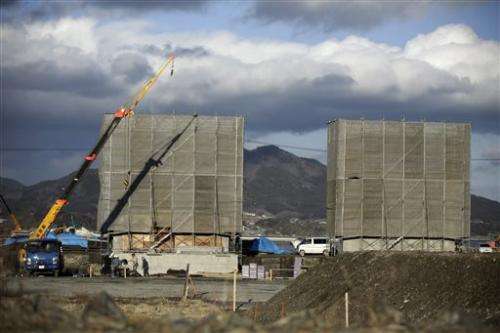
"The safest thing is for people to live on higher ground and for people's homes and their workplaces to be in separate locations. If we do that, we don't need to have a 'Great Wall,'" he said.
While the lack of basic infrastructure can be catastrophic in developing countries, too heavy a reliance on such safeguards can lead communities to be too complacent at times, says Margareta Wahlstrom, head of the U.N.'s Office for Disaster Risk Reduction.
"There's a bit of an overbelief in technology as a solution, even though everything we have learned demonstrates that people's own insights and instincts are really what makes a difference, and technology in fact makes us a bit more vulnerable," Wahlstrom said in an interview ahead of a recent conference in Sendai convened to draft a new framework for reducing disaster risks.
In the steelmaking town of Kamaishi, more than 1,000 people died in the 2011 tsunami, but most school students fled to safety zones immediately after the earthquake, thanks to training by a civil engineering professor, Toshitaka Katada.
The risk is not confined to Japan, said Maarten van Aalst, director of the Red Cross/Red Crescent Climate Center, who sees this in the attitudes of fellow Dutch people who trust in their low-lying country's defenses against the sea.
"The public impression of safety is so high, they would have no idea what to do in case of a catastrophe," he said.
Despite pockets of opposition, getting people to agree to forego the sea walls and opt instead for Hosokawa's "Great Forest Wall" plan is a tough sell, says Tomoaki Takahashi, whose job is to win support for the forest project in local communities.
"Actually, many people are in favor of the sea walls, because they will create jobs," said Takahashi. "But even people who really don't like the idea also feel as if they would be shunned if they don't go along with those who support the plan," he said.
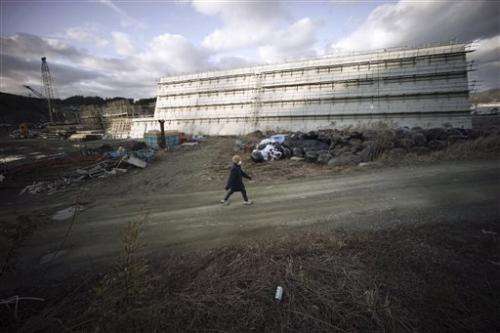
While the "Great Forest Wall" being planted in some areas would not stave off flooding, it would slow tsunamis and weaken the force of their waves. As waters recede, the vegetation would help prevent buildings and other debris from flowing back out to sea. Such projects would also allow rain water to flow back into the sea, a vital element of marine ecology.
Some voices in unexpected places are urging a rethink of the plan.
Prime Minister Shinzo Abe's wife, Akie, offered numerous objections to cementing the northeast coast in a speech in New York last September. She said the walls may prevent residents from keeping an eye out for future tsunamis and would be costly to maintain for already dwindling coastal communities.
"Please do not proceed even if it's already decided," she said. Instead of a one-size-fits-all policy, she suggested making the plan more flexible. "I ask, is building high sea walls to shield the coast line really, really the best?"
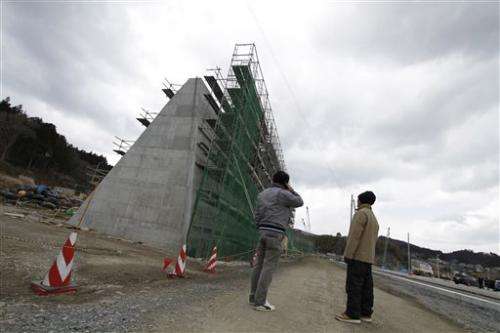
Rikuzentakata, a small city near Osabe whose downtown area was wiped out by the tsunami, is building a higher sea wall, but also moving many tons of earth to raise the land well above sea level.
Local leader Takeshi Konno said no construction project will eliminate the need for coastal residents to protect themselves.
"What I want to stress is that no matter what people try to create, it won't beat nature, so we humans need to find a way to co-exist with nature," Konno said. "Escaping when there is danger . the most important thing is to save your life."
-
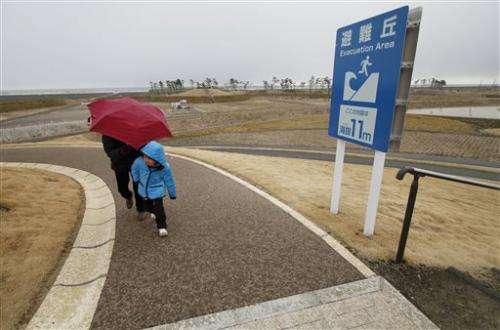
In this March 13, 2015 photo, a woman and a boy walk up a hill, 11-meter (36 feet) above sea level, with a tsunami evacuation sign standing at the "Millennium Hope Hills" park in Iwanuma, Miyagi prefecture, northeastern Japan. Four years after a towering tsunami ravaged much of Japan's northeastern coast, efforts to fend off future disasters are focusing on a nearly 400-kilometer (250 mile) chain of cement sea walls, at places nearly five stories high. (AP Photo/Koji Ueda) -
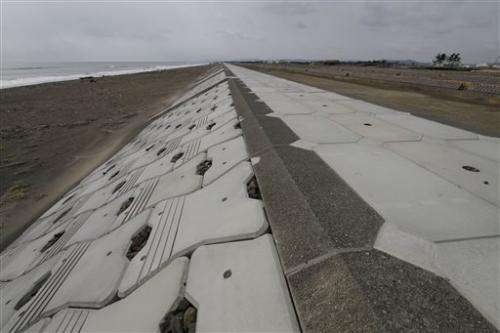
In this March 13, 2015 photo, a 7.2 meter (23 feet 7 inches) high concrete sea wall is seen along the shore at the "Millennium Hope Hills" park in Iwanuma, Miyagi prefecture, northeastern Japan. Four years after a towering tsunami ravaged much of Japan's northeastern coast, efforts to fend off future disasters are focusing on a nearly 400-kilometer (250 mile) chain of cement sea walls, at places nearly five stories high. (AP Photo/Koji Ueda) -
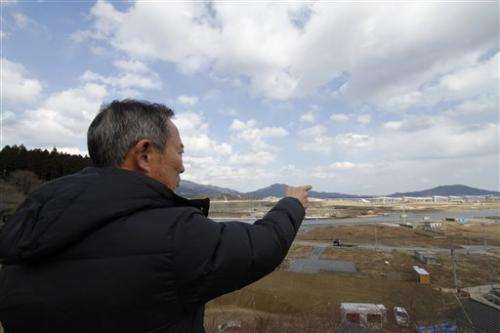
In this March 12, 2015 photo, local leader Takeshi Konno points at a construction site in Rikuzentakata, Iwate Prefecture, northeastern Japan. Four years after a towering tsunami ravaged much of Japan's northeastern coast, efforts to fend off future disasters are focusing on a nearly 400-kilometer (250-mile) chain of cement sea walls, at places nearly five stories high. Konno said no construction project will eliminate the need for coastal residents to protect themselves. (AP Photo/Koji Ueda)
© 2015 The Associated Press. All rights reserved.



















